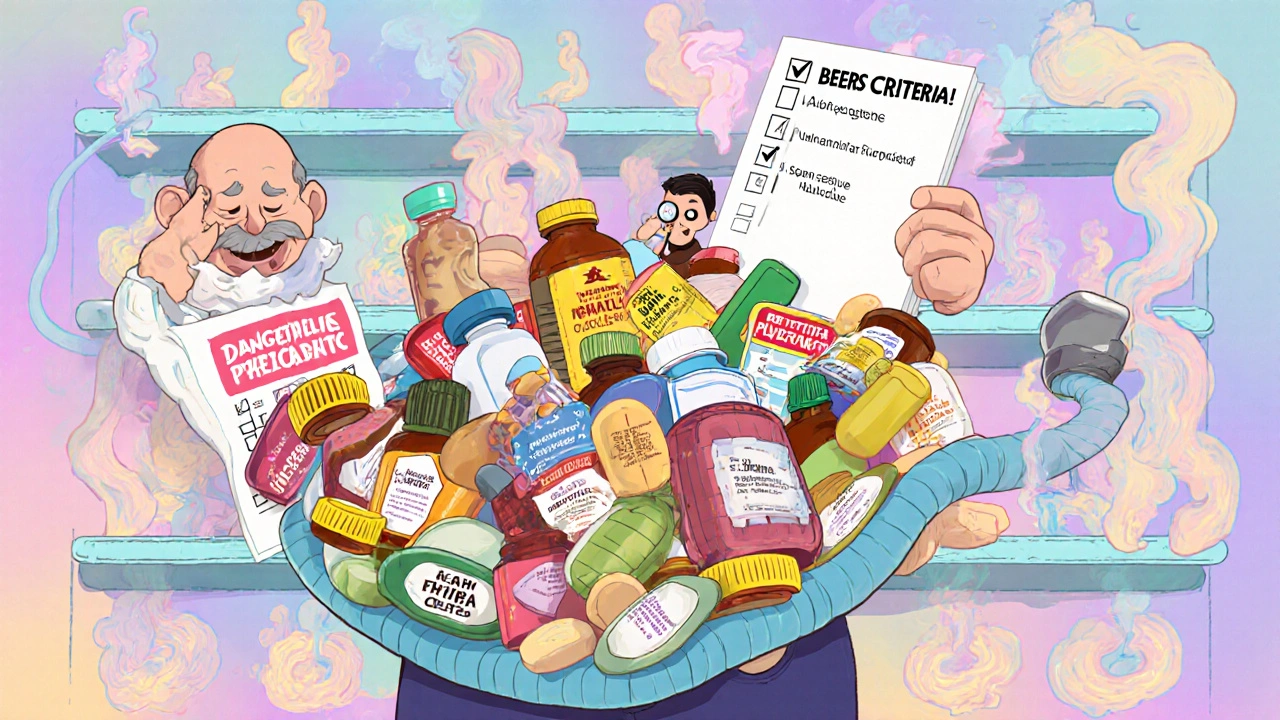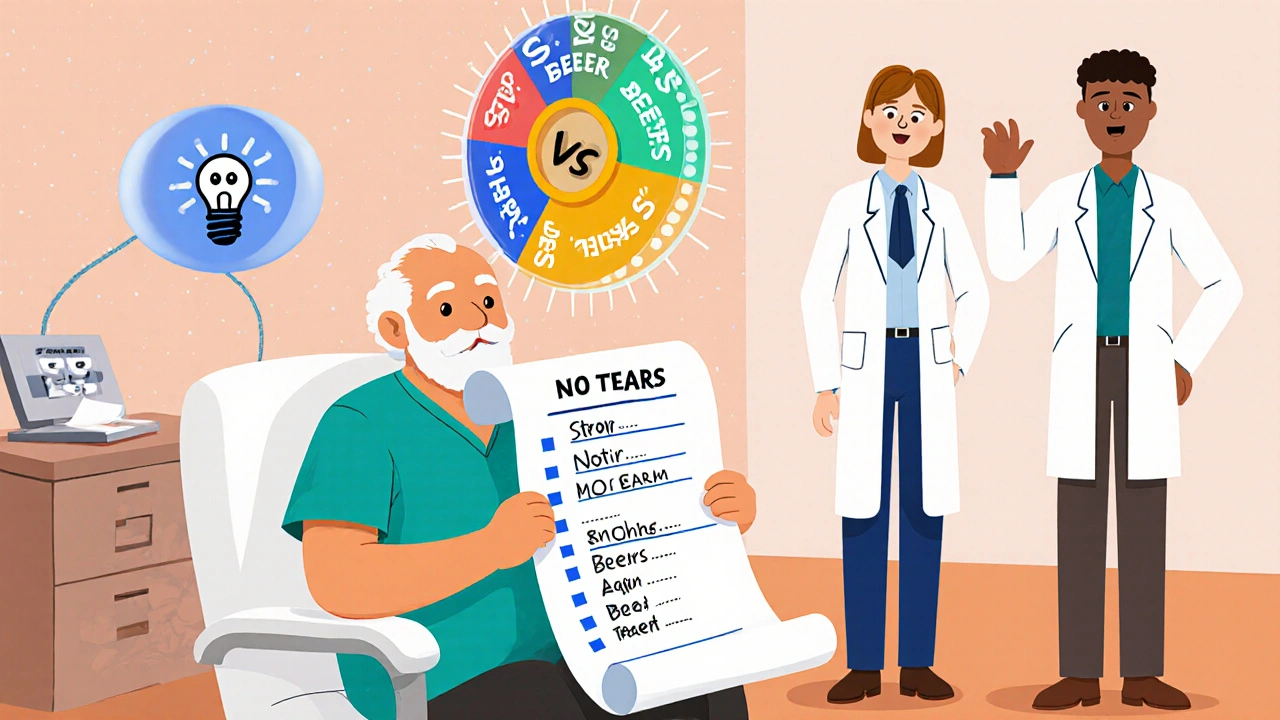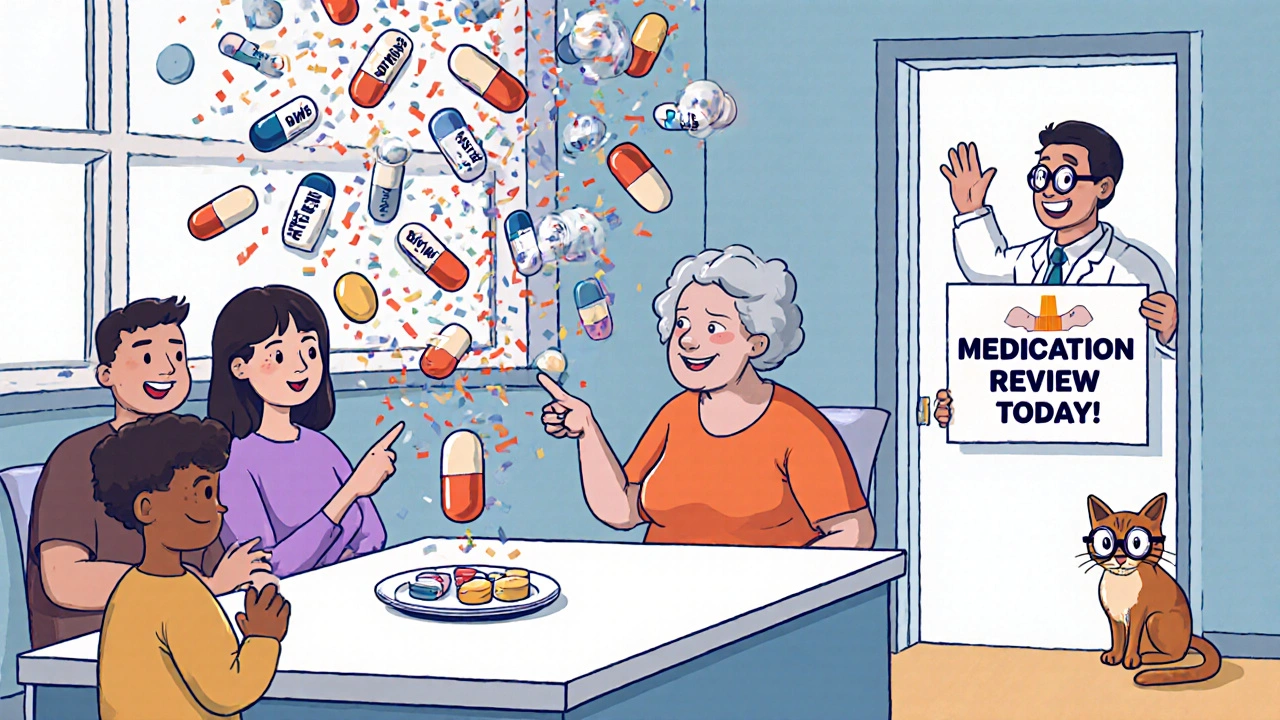
Older adults are at serious risk for harmful drug-drug interactions. More than 40% of people over 65 take five or more medications daily. That’s not just common-it’s dangerous. When multiple drugs mix, they can cancel each other out, overload the body, or cause unexpected side effects like confusion, falls, or kidney failure. The problem isn’t the drugs themselves. It’s how they’re managed.
Why Seniors Are More Vulnerable
As we age, the body changes in ways that make medications behave differently. The liver doesn’t process drugs as quickly. The kidneys clear them out slower. Body fat increases while water content drops. That means drugs stick around longer, build up in the system, and become more potent-even at the same dose.Up to 50% more seniors experience bad reactions compared to younger adults. This isn’t because they’re taking more pills by accident. It’s because their bodies can’t handle what younger ones could. Add in multiple doctors, different pharmacies, and over-the-counter supplements, and the risk skyrockets.
Many seniors take herbal products like St. John’s wort, ginkgo, or garlic pills. These aren’t harmless. St. John’s wort can make blood thinners, antidepressants, and even heart meds useless. Ginkgo increases bleeding risk when mixed with aspirin or warfarin. But 68% of older adults don’t tell their doctors about these supplements. Why? They think they’re natural, so they’re safe. They’re wrong.
The Most Dangerous Drug Combinations
Some drug pairs are especially risky for seniors. The most common serious interactions happen in two areas: the heart and the brain.Cardiovascular drugs like warfarin, digoxin, and beta-blockers are involved in nearly 39% of life-threatening interactions. Mixing warfarin with certain antibiotics or NSAIDs like ibuprofen can cause dangerous bleeding. Digoxin levels spike when taken with amiodarone or verapamil, leading to heart rhythm problems.
CNS drugs-antidepressants, antipsychotics, benzodiazepines, and pain meds-are behind 29% of serious interactions. Combining opioids with benzodiazepines can slow breathing to a stop. SSRIs with tramadol or linezolid can trigger serotonin syndrome: high fever, muscle rigidity, seizures. These aren’t rare. They’re preventable.
The American Geriatrics Society’s Beers Criteria lists 30 medication classes to avoid in seniors and 40 that need dose changes based on kidney function. For example, diphenhydramine (Benadryl) is on the list. It’s in sleep aids, allergy pills, and cold meds. It causes dizziness, confusion, and urinary retention in older adults. Yet it’s still sold over the counter. And many doctors still prescribe it.
Tools That Actually Work
There are proven tools to catch these interactions before they hurt someone. Two of the most reliable are the Beers Criteria and STOPP.Beers Criteria is updated every two years. The 2023 version tells doctors exactly which drugs to avoid or adjust. A 2022 study in JAMA Internal Medicine found that hospitals using Beers Criteria reduced hospitalizations by 17.3% in seniors.
STOPP (Screening Tool of Older Persons’ Potentially Inappropriate Prescriptions) goes further. It lists 114 specific inappropriate prescriptions across 22 systems. A 2021 study in the Journal of the American Geriatrics Society showed that using STOPP during hospital discharge cut inappropriate prescribing by 34.7% and lowered readmissions by 22.1%.
Another practical method is NO TEARS. It’s not a checklist. It’s a conversation starter. Each letter stands for a question:
- Need: Is this drug still necessary?
- Optimization: Is the dose right for kidney or liver function?
- Trade-offs: Do the benefits outweigh the risks?
- Economics: Can the patient afford it?
- Administration: Are they taking it correctly?
- Reduction: Can we stop one or two?
- Self-management: Do they understand why they’re taking it?
Doctors who use NO TEARS spend more time listening. They ask, “What’s your biggest concern about your meds?” That simple question uncovers missed interactions, forgotten pills, or fear of side effects.

Who’s Responsible?
Preventing drug interactions isn’t one person’s job. It’s a team effort.Patients often don’t know what they’re taking. One man in Brisbane was on eight medications. He didn’t know three were for high blood pressure. His wife kept giving him a “natural heart tonic” she bought online. Turns out, it had hidden amounts of digoxin. He ended up in the ER.
Doctors rarely talk to each other. More than two-thirds of seniors see multiple providers. One doctor prescribes a new statin. Another adds an NSAID for arthritis. Neither knows about the other’s prescription. Pharmacies don’t always share data either. If you fill prescriptions at CVS, Walgreens, and a local pharmacy, there’s no central record.
Pharmacists are the hidden safety net. But only 15% of community pharmacies in Australia have formal medication review programs. Medicare’s Medication Therapy Management program helps-but only 11.2 million of the 65+ population use it. That’s less than half.
What You Can Do Right Now
You don’t need a PhD to protect yourself or a loved one. Start with these steps:- Make a complete list. Write down every pill, patch, inhaler, injection, vitamin, and herbal supplement. Include doses and why you take them.
- Bring it to every appointment. Don’t rely on memory. Don’t let the doctor guess. Hand them the list.
- Ask: “Can any of these be stopped?” Many seniors take meds they haven’t needed for years. A blood thinner after a one-time clot? A statin after a heart attack five years ago? Ask if it’s still needed.
- Use one pharmacy. If you use multiple, ask your doctor to switch to one. That way, the pharmacist can flag interactions.
- Check for Beers Criteria drugs. Look up the list. If you’re on any of them, ask why. Don’t assume it’s safe just because your doctor prescribed it.
Also, don’t wait for symptoms. If you feel more tired than usual, dizzy, confused, or have unexplained bruising, it could be a drug interaction. Don’t brush it off as “just getting older.”

The Bigger Picture
The system is broken. Clinical trials rarely include seniors. Less than 5% of participants in drug trials are over 65-even though older adults take 30% of all prescriptions. That means we’re guessing how drugs work in them.The FDA now requires more geriatric data, but only 18% of new drugs between 2018 and 2022 included it. AI tools are helping hospitals catch interactions faster, but adoption is still low. Only 47% of U.S. hospitals use them now.
Medical schools teach almost nothing about geriatric pharmacology. Only 38% of U.S. schools have a dedicated course. That’s changing slowly-by 2026, it’s expected to rise to 65%. But right now, many doctors are flying blind.
And the numbers will only grow. By 2030, one in five Americans will be over 65. If we don’t fix how we manage medications now, we’ll face a wave of preventable hospitalizations, falls, and deaths.
Final Thought: It’s Not About Cutting Meds. It’s About Cutting Risk.
Stopping a drug isn’t always the answer. Sometimes, switching to a safer one is. Sometimes, adjusting the dose is enough. The goal isn’t to take fewer pills. It’s to take the right ones, at the right dose, for the right reason.Ask questions. Speak up. Bring the list. Push for a review. You have the power to prevent harm-even if your doctor doesn’t bring it up first.
What are the most common drug interactions in elderly patients?
The most common dangerous interactions involve heart medications like warfarin, digoxin, and beta-blockers, and brain-affecting drugs like antidepressants, benzodiazepines, and opioids. Mixing warfarin with NSAIDs like ibuprofen can cause bleeding. Combining SSRIs with tramadol can trigger serotonin syndrome. Benzodiazepines with opioids can slow breathing to dangerous levels. These interactions are frequent because seniors often take multiple drugs for chronic conditions and don’t always know how they interact.
Can over-the-counter meds cause interactions too?
Yes. Over-the-counter drugs like ibuprofen, naproxen, and antacids can interact with prescription meds. Even common supplements like St. John’s wort, ginkgo, garlic, and fish oil can interfere with blood thinners, antidepressants, and blood pressure drugs. Many seniors don’t tell their doctors about OTC or herbal products because they assume they’re safe. That’s a major blind spot.
How often should seniors have their medications reviewed?
Seniors taking five or more medications should have a full review at least once a year-and more often after hospital stays, new diagnoses, or changes in health. Many experts recommend reviewing meds every 3-6 months for those on seven or more drugs. The key is consistency. Don’t wait for a crisis. Make it part of regular checkups.
What is the Beers Criteria and why does it matter?
The Beers Criteria is a list of medications that are potentially inappropriate for older adults due to high risk of side effects or lack of benefit. Updated every two years by the American Geriatrics Society, it identifies 30 drug classes to avoid and 40 that need dose adjustments based on kidney function. Using it reduces hospitalizations by up to 17.3%. It’s a trusted tool doctors can use to spot risky prescriptions before they cause harm.
Can AI help prevent drug interactions in seniors?
Yes. AI-powered clinical decision support systems now flag potential drug interactions in real time as doctors write prescriptions. Adoption has jumped from 22% of U.S. hospitals in 2020 to 47% in 2023. These tools can cross-reference hundreds of drugs, supplements, and patient data like kidney function to warn of risks. But they’re not perfect-they still miss interactions involving herbal products or non-prescription meds if those aren’t entered into the system.
What should I do if I think my meds are causing side effects?
Don’t stop taking them on your own. Write down exactly what you’re feeling-when it started, how often, and what you were taking at the time. Bring your full medication list to your doctor. Ask: “Could this be a drug interaction?” Most side effects in seniors are wrongly blamed on aging. They’re often caused by a drug combination that can be fixed with a simple change.

 Health and Wellness
Health and Wellness
Willie Doherty
November 22, 2025 AT 11:54The data presented here is methodologically sound, particularly the citation of JAMA and JAGS studies on Beers Criteria and STOPP. However, the absence of a discussion on polypharmacy as a systemic failure of reimbursement models-wherein each specialist is incentivized to add, not subtract-is a critical omission. The economic architecture of care is the root cause, not merely individual ignorance.
Cooper Long
November 23, 2025 AT 06:43Beers Criteria is useful but outdated. It doesn't account for individual variability in pharmacogenomics. A 72-year-old with CYP2D6 ultra-rapid metabolism may metabolize codeine differently than their peer. Personalized medicine isn't optional anymore-it's the baseline standard we're failing to implement.
Sheldon Bazinga
November 24, 2025 AT 02:31lol so now we gotta babysit old people bc they cant read the label on benadryl? smh. my grandpa took 12 pills a day and lived to 94. you people overcomplicate everything. just tell em to stop taking the green ones and call it a day.
Shawn Sakura
November 24, 2025 AT 15:44This is one of the most important pieces I've read all year. Seriously. I work with seniors daily and the gap between what's recommended and what actually happens is heartbreaking. The NO TEARS framework? That's gold. I'm printing it out and giving it to every family I meet. You're not just saving lives-you're restoring dignity. Thank you.
Simone Wood
November 24, 2025 AT 15:44Did you know that 89% of all geriatric drug interactions are caused by pharmaceutical companies pushing off-label use? The FDA is complicit. And don't get me started on how Medicare Advantage plans refuse to cover pharmacist consultations unless the patient is in hospice. This is a profit-driven massacre disguised as healthcare.
Swati Jain
November 26, 2025 AT 09:56Oh please. You think the Beers Criteria is the solution? Honey, I've seen geriatricians prescribe a beta-blocker, then add an SSRI, then a NSAID, then a statin, then a benzodiazepine-and then wonder why the patient is hallucinating. The real problem? Doctors are trained to treat symptoms, not people. And if you're not on 7 meds by 70, you're not 'doing it right.' This isn't medicine. It's pharmaceutical performance art.
Florian Moser
November 26, 2025 AT 10:41Thank you for writing this with such clarity and care. The NO TEARS framework is not just practical-it's compassionate. Too often, we treat medication reviews as checkboxes. But asking 'What's your biggest concern?' transforms the entire dynamic. This should be required reading for every medical student. And for every family caregiver. Please share this everywhere.
jim cerqua
November 26, 2025 AT 18:40Let me tell you something. I lost my mother to a drug interaction. She was on warfarin. Took ibuprofen for her knees. Didn't think twice. One morning, she just… stopped breathing. Not a heart attack. Not a stroke. A bleeding brain. All because the pharmacist didn't have her full list and the doctor didn't ask. And now? Now I see the same thing happening to my neighbors. This isn't an article. It's a warning. A scream. And nobody's listening.
Donald Frantz
November 28, 2025 AT 14:27Why are we still relying on paper lists? Every pharmacy has an EHR. Every hospital has an API. Why isn't there a national, real-time, interoperable medication registry? This isn't a patient education problem-it's a technological failure. We have the tools. We just lack the political will. And that’s criminal.
Sammy Williams
November 28, 2025 AT 18:29my dad just started on a new med last week and he’s been super dizzy. i was gonna say ‘oh it’s just age’ but then i remembered this post. made him write down every single thing he’s taking-even the turmeric gummies. we’re taking it to his doc next week. small step, but i feel like we’re finally doing something.
Julia Strothers
November 30, 2025 AT 07:45This is all part of the Great Elderly Eradication Plan. The CDC, Big Pharma, and the AMA are quietly pushing geriatric polypharmacy because it keeps the elderly dependent, docile, and expensive. They know if seniors could manage their own meds, they’d start asking about Medicare for All. So they flood them with pills, then blame them for the side effects. Wake up. This is genocide by prescription.
Erika Sta. Maria
November 30, 2025 AT 10:51But what if the real issue isn't the drugs but the metaphysics of aging? We treat the body like a machine that breaks down, but what if aging is a spiritual transition? Maybe the pills are just a distraction from the deeper existential imbalance. I mean, have you ever considered that the liver slows down because the soul is preparing to leave? The Beers Criteria is just modernity's attempt to deny death with more chemicals.